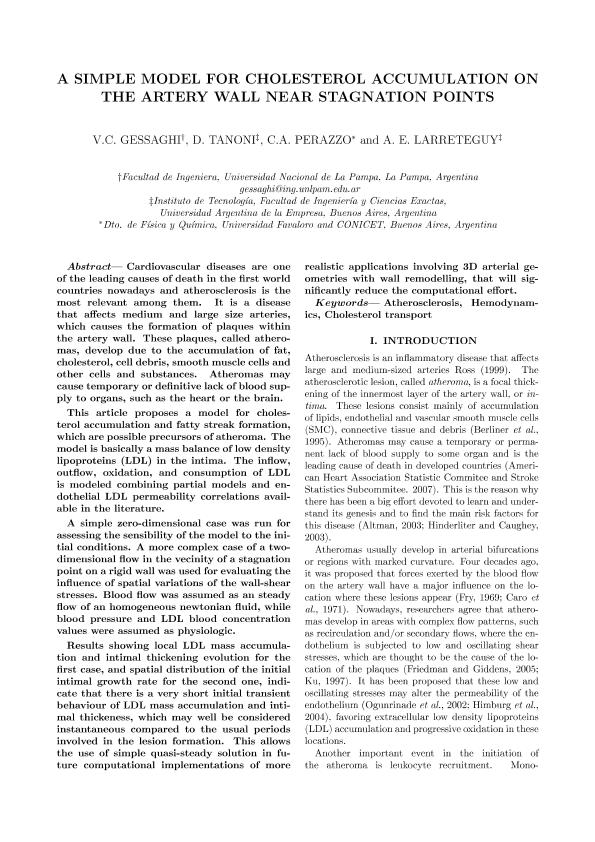Artículo
A simple model for cholesterol accumulation on the artery wall near stagnation points
Fecha de publicación:
04/2012
Editorial:
Planta Piloto de Ingeniería Química
Revista:
Latin American Applied Research
ISSN:
0327-0793
e-ISSN:
1851-8796
Idioma:
Inglés
Tipo de recurso:
Artículo publicado
Clasificación temática:
Resumen
Cardiovascular diseases are one of the leading causes of death in the first world countries nowadays and atherosclerosis is the most relevant among them. It is a disease that affects medium and large size arteries, which causes the formation of plaques within the artery wall. These plaques, called athero- mas, develop due to the accumulation of fat, cholesterol, cell debris, smooth muscle cells and other cells and substances. Atheromas may cause temporary or definitive lack of blood sup ply to organs, such as the heart or the brain. This article proposes a model for choles terol accumulation and fatty streak formation, which are possible precursors of atheroma. The model is basically a mass balance of low density lipoproteins (LDL) in the intima. The inflow, outflow, oxidation, and consumption of LDL is modeled combining partial models and en dothelial LDL permeability correlations avail able in the literature. A simple zero-dimensional case was run for assessing the sensibility of the model to the ini- tial conditions. A more complex case of a two- dimensional flow in the vecinity of a stagnation point on a rigid wall was used for evaluating the influence of spatial variations of the wall-shear stresses. Blood ow was assumed as an steady flow of an homogeneous newtonian fluid, while blood pressure and LDL blood concentration values were assumed as physiologic. Results showing local LDL mass accumula- tion and intimal thickening evolution for the first case, and spatial distribution of the initial intimal growth rate for the second one, indicate that there is a very short initial transient behaviour of LDL mass accumulation and inti- mal thickeness, which may well be considered instantaneous compared to the usual periods involved in the lesion formation. This allows the use of simple quasi-steady solution in future computational implementations of more realistic applications involving 3D arterial geometries with wall remodelling, that will significantly reduce the computational effort.
Palabras clave:
Atherosclerosis
,
Hemodynamics
,
Cholesterol transport
Archivos asociados
Licencia
Identificadores
Colecciones
Articulos(SEDE CENTRAL)
Articulos de SEDE CENTRAL
Articulos de SEDE CENTRAL
Citación
Gessaghi, Valeria Cristina; Tanoni, Debora; Perazzo, Carlos Alberto; Larreteguy, Axel Eduardo; A simple model for cholesterol accumulation on the artery wall near stagnation points; Planta Piloto de Ingeniería Química; Latin American Applied Research; 42; 4-2012; 1-9
Compartir




